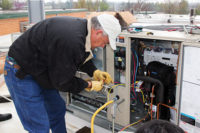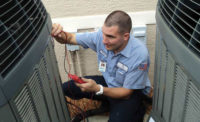Another way to cut down costs is to make strategic retrofits that can improve the efficiency and safety of older boiler systems. Of course, if a gas boiler is on its last legs, it may be better to replace it rather than perform any costly retrofits, and this is a discussion that contractors should have with their customers, so they can make an informed decision that is right for their situation.
Importance of Maintenance
Regular maintenance contributes significantly to a boiler’s efficiency, noted Matt Downs, product engineer, Weil-McLain, particularly on high-efficiency products. “Annual maintenance by a qualified contractor is highly recommended — or required — by most manufacturers. If the boiler is operating in low-temperature applications, which contributes to higher efficiencies, the heat exchanger and condensate trap require annual maintenance to maintain the higher efficiency levels. In addition, contractors should verify the combustion setup, possibly replace the ignitor, and check the water quality, seals, and vent system.”
Contractors need to be aware, however, that each manufacturer has a recommended maintenance schedule, and maintenance schedules can vary from one manufacturer to another, stated Jeff Vallett II, product manager, Lochinvar Corp. “For example, Lochinvar has a specific maintenance schedule for our Knight boiler, which is a stainless steel, high-efficiency condensing boiler.” (See Figure 1.)
Regular maintenance not only improves efficiency, it is necessary to ensure the boiler is operating under safe conditions, said Don DeCarr, technical support representative, ECR International. “We recommend yearly maintenance checks that include cleaning of the boiler and cycle/testing all operating and safety controls. Additionally, any valves or controls that are part of the boiler system should be checked, using appropriate test equipment as designated by the boiler manufacturer.”
Mike McDonnell, business manager, PB Heat LLC/Peerless Boilers, noted that the boiler system will perform better and last longer with a consistent maintenance program. “The terminology is not necessarily service but rather inspection. In our manuals we suggest a yearly inspection of the safety and operating components of a heating system, including the chimney or other exhaust termination, air intake vent, boiler limits, valves, sensors, circulators (pumps), dampers, thermostats, and condition of space around the heating appliance. Also the flue exhaust gases should be checked with an analyzer to ensure that the boiler is tuned properly.”
Regular maintenance is particularly important in optimizing efficiency because dirty combustion chambers will reduce the heat exchangers’ ability to properly transfer heat from the burner to the boiler water, stated Chuck O’Donnell, product marketing manager, Laars Heating Systems. “Residential boilers should be inspected yearly before the winter weather, and light commercial boilers may need to be inspected multiple times per year, depending on their operating conditions.”
While O’Donnell agrees that contractors need to follow the manufacturer’s recommended maintenance schedule, he said, in general, the following items should be included as part of regular boiler maintenance:
• Inspect integrity of the electrical system;
• Remove and inspect the burner;
• Inspect the combustion chamber and clean out any precipitates;
• Inspect vent system to be sure there are no signs of deterioration;
• Check flame sensing rods to be sure they are operating properly;
• Check fans and blowers for dirt buildup and clean if needed;
• Clean air filter;
• Check safeties and controls;
• When done, fire boiler and measure the flue gas temperature to be sure it is at the proper level; if too low, condensate can build and deteriorate the venting; and
• Always have the oxygen, carbon monoxide, and carbon dioxide levels in the flue checked and balanced per the appliance manual, from low fire to high fire. High efficiency boilers require the use of a combustion analyzer to properly conduct this test. By doing so, it is determined that the boiler is running cleanly and safely at its optimum efficiency.
Jason Bostock, product manager, Bosch Thermotechnology, said that regular boiler maintenance can be compared to the routine maintenance that is performed on a car to keep it running efficiently. “Part of the service procedure should be to conduct a combustion analysis of the fuel burnt. Similar in the way that a car has to have its emissions checked every year, tuning boiler combustion can ensure it is burning cleanly and efficiently. It is also beneficial to check the internal components of a boiler and also the external system on a regular basis, as any anomaly can be corrected and can possibly ensure the safe operation of a heating system throughout the year.”
Smart Retrofits
Customers looking to improve the efficiency of their gas-fired boilers may want to take advantage of several retrofits that are available for existing equipment. That being said, retrofits can be a double-edged sword, said DeCarr. “Changing from standing pilot to intermittent ignition or adding a vent damper sounds straightforward, however, we only recommend it if the kit is factory authorized. If the kit is manufactured by a third party, the boiler has now been altered from the original design, and the contractor assumes a great deal of liability should the system malfunction, causing damage to the boiler, or worse, to the home or people in it.”
Adding new controls may be a smart retrofit, and according to McDonnell, there are many controls on the market today that can maximize every firing cycle of the burner to lower fuel bills and dramatically raise boiler and system efficiency. He stated that these controls are relatively easy to install, and they work with the boiler to get the most out of every fuel dollar spent.
“Cost of these smart controls will vary depending on the type of system, but it can be said that they will produce a very short payback time, as they do contribute significantly to the increased efficiency of the appliance and the system,” said McDonnell. “Most of the smart controls adjust the boiler temperature automatically to a variable set point (that is controlled by the amount of heat needed to overcome the home’s heat loss) and then distribute the heat to where it is needed the most.”
The outdoor reset control is a popular retrofit, as it increases the target set point temperature as the outside air temperature decreases. “Many new boilers have this feature built into the controls, so installation may be as simple as installing the outdoor air sensor and programming the boiler control for the appropriate reset curve,” said Vallett. “If the boiler in question does not have outdoor reset capabilities built in, it is possible to add a third-party control that is capable of lowering the target water temperature as the outdoor temperature increases. The addition of outdoor reset on condensing boilers can increase efficiency by as much as 10 percent.”
Starting in 2012, manufacturers will be required to provide an outdoor reset control on boilers sold in the United States, noted Bostock, which will help ensure that boilers stay as efficient as possible. “When compared to a regular thermostat on a system with no outdoor reset, the possible savings can be 6 to 10 percent per year. This may not sound like a lot over one year, but one should take into account the use of a control like this over a span of 5 to 10 years. It is almost guaranteed that fuel prices will rise over this time, so a small initial investment can pay for itself in a relatively short period of time.”
Swapping out older thermostats for the programmable kind also makes sense, stated O’Donnell, as they allow for room temperature levels to be automatically reduced when people are not home, which reduces the number of times the boiler needs to fire throughout the day. He noted that adding zone controls to older systems that are not zoned or have minimal zones is another smart retrofit, as the hot water is only pumped to the areas that require heat.
A retrofit that Downs recommends is adding a high-efficiency boiler to the system that is capable of handling the load during the shoulder seasons (spring and fall). “This arrangement can take advantage of lower water temperatures and better match the requirements of the structure, resulting in a high efficiency system with redundancy that requires minimal investment compared to an entirely new system.”
Time to Replace
At some point, an older boiler will need to be replaced, particularly if the equipment is leaking water or products of combustion. If a boiler is in a condition that makes it unsafe to operate, then owners should consider replacing it immediately.
“Boilers that have advanced corrosion or obsolete parts should be replaced,” said DeCarr.
“A good rule of thumb is if the repair is 50 percent or more of the cost of a new boiler, replace it. That being said, cast iron boilers are battle tanks. I routinely talk to people with 30- and 40-year-old boilers that are still operating satisfactorily; however, they are only operating at the efficiency that was built into them many years ago, which is nowhere near what is manufactured today. The key is for contractors to do their homework and show the payback associated with the increased efficiencies of today’s equipment.”
Vallett agrees, noting that if the boiler is in safe operating condition and is merely inefficient due to normal wear and tear, then a financial analysis should be conducted to determine if a boiler replacement is practical. “Factors to consider when helping customers make the decision to replace a boiler should include — at a minimum — installed cost and return on investment to ensure that a new, more efficient boiler will yield the fuel savings results that are required for the investment to make sense.”
One of the reasons why boilers become candidates for replacement may be a result of water chemistry not being properly balanced over the years, noted Mark Avron, boiler national sales manager, Bosch Thermotechnology. “Over the course of many years minerals, scale, corrosion, etc. can build up on a boiler’s heat exchanger and, if not maintained, it can become impossible to thoroughly clean, resulting in reduced efficiency. Then it may be time to consider replacement.”
Increasing maintenance costs and calls for service are other reasons why homeowners may want to consider replacing their boilers, noted McDonnell. “Customers may want to reduce their heating costs as well, and with good reason. Older boilers may be as low as 70 percent efficient, and new boilers can be installed with efficiencies in the 97 percent range. This will allow for significant savings.”
A new boiler may also be needed if an owner has remodeled or added floor space to their home. Many times other improvements have been made to a structure, such as new doors, windows, and insulation upgrades that have reduced the heating requirements of a home or business, said O’Donnell. “That may mean that the existing boiler is now oversized for the building’s new heating needs, and a new, smaller output, higher-efficiency boiler should be considered for the replacement. It is a double win for the homeowner because the boiler will be the correct size for the building, and it will use less fuel because it is both smaller and more efficient.”
Besides saving energy, new boilers are also significantly smaller than older equipment, and in many cases, can be mounted on the wall or installed in a closet. Even if customers opt to purchase a shiny new boiler, they should be aware that regular maintenance by a qualified contractor is the best way to ensure their new equipment continues to perform optimally for many years to come.
Publication date: 10/24/2011















